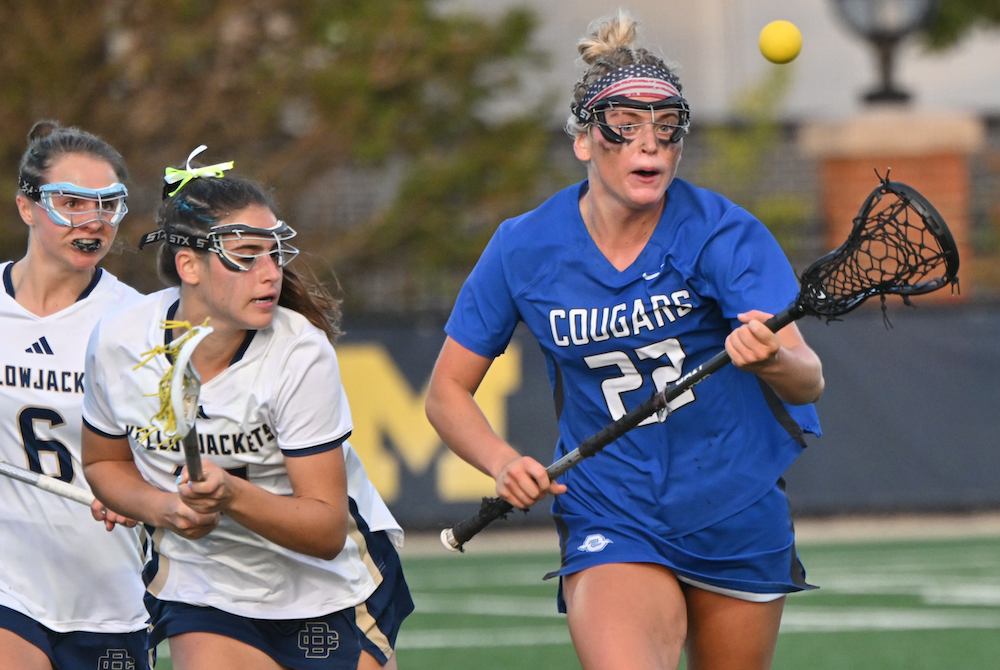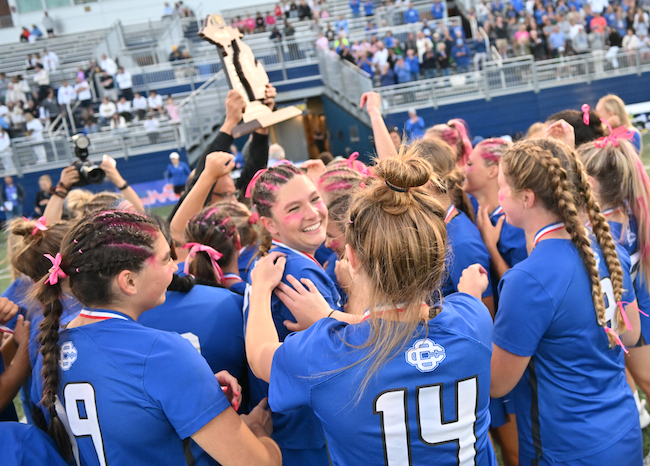
Casting Lines for Future Tournaments
August 12, 2016
By Jack Roberts
MHSAA Executive Director
The MHSAA is best known to the public for the tournaments it conducts to conclude the fall, winter and spring seasons each school year.
These tournaments, the first and largest program of the MHSAA, have survived the Vietnam War, the Korean conflict and two World Wars. They have survived the technology bubble, the housing collapse, the energy crisis and the Great Depression.
MHSAA tournaments existed at the dawn of aviation and at the time of our nation’s lunar landing. Popes, presidents and governors have changed and changed again and again, and MHSAA tournaments roll on year after year.
But the sense of tradition and permanence and inevitability of MHSAA tournaments doesn’t dissuade us from asking questions about our tournaments, even some of the most basic questions. Here are two.
Question #1
I have long been and will always be an advocate for a Ryder Cup format for the MHSAA Golf Finals, and a team tennis approach to the MHSAA Tennis Finals; but 90 years of tradition is hard to overcome. Might this be a more exciting format? Could it be co-ed? Could it reverse the decline in boys tennis participation, and increase girls golf participation? Wouldn’t it be fun to try?
Periodically, the International Olympic Committee requires each of the designated Olympic sports to defend its status, to state its case why the sport should remain a part of the Olympic program. Then, after a series or votes that retain one sport at a time, the IOC drops the sport that makes the weakest case. It does so to make room for one of the previously unlisted sports that makes the best case for inclusion.
This would appear to keep the existing Olympic sports on their toes, and to keep the Olympic movement fresh and reflective of modern trends in sports.
While I would not enjoy the controversy, I can see the potential for some positive results if the MHSAA were to invoke the same policy for determining the 14 tournaments it will provide for girls and the 14 for boys.
This might cause us to consider more deeply what a high school sport should look like, or at least what an MHSAA tournament sport should stand for.
On the one hand, we might be inclined to drop tournaments for those sports that involve mostly non-faculty coaches and non-school venues, or require cooperative programs to generate enough participants to support a team, or resort almost entirely to non-school funding, or cater to individuals more than teams.
Or perhaps this process would cause policymakers to forget traditional thinking and ask: “In this day and age, should we shake off traditional notions of sport and consider more where modern kids are coming from?” That might mean fewer team sports and more individual sports, more “extreme” sports like snowboarding and skateboarding, and more lifetime sports, meaning not just golf and tennis and running sports, but also fishing and even shooting sports.
Currently, MHSAA policy states that the MHSAA will consider sponsorship of a tournament series for any sport which 64 member schools conduct on an interscholastic basis as a result of action by the governing boards of those schools.
Should the only question be how many schools sponsor a sport, or must an activity also have certain qualities and/or avoid certain “defects?” What should an MHSAA tournament sport look like and stand for?
Question #2
Bristling from criticism that his association is a money-grabbing exploiter of children, my counterpart in another state said, “If we were running our programs just to make money, we would do very many things very differently.” I knew exactly what he meant.
Because we care about the health and welfare of students, because we mean what we say that the athletic program needs to maximize the ways it enhances the school experience while minimizing academic conflicts, and because we try to model our claim that no sport is a minor sport when it comes to its potential to teach young people life lessons, we operate our programs in ways that make promoters, marketers and business entrepreneurs laugh, cry or cringe.
If money were the only object, we would seed and select sites to assure the teams that attracted the most spectators had the best chance to advance in our tournaments, regardless of the travel for any team or its fan base. If money were the only object, we would never schedule two tournaments to overlap and compete for public attention, much less tolerate three or four overlapping events. If money were the only object, we would allow signage like NASCAR events and promotions like minor league baseball games.
Those approaches to event sponsorship may not be all wrong; they’re just not all right for us. And we will live with the consequences of our belief system.
During a typical school year, more than 20 percent of the MHSAA’s 2,097 District, Regional and Final tournaments lose money. Not a single site in golf, skiing or tennis makes a single penny. In no sport did every District, Regional and Final site have revenue in excess of direct expenses.
In fact, in only three sports – boys and girls basketball and football – is revenue so much greater than direct expenses overall that it helps to pay for all the other tournaments in which the MHSAA invests.
That’s right: invests. When we present our budget to our board, we talk about the MHSAA’s investment in providing tournament opportunities in all those sports and all those places that cannot sustain the cost of those events on their own. How much is this investment worth to students, schools and society?
These two are core questions that require our focus far in advance of talk about scheduling, site selection, seeding and the myriad matters that too often hijack our time and attention.

Super Scorer Marosi, Grand Rapids Catholic Central Complete Perfect Run
By
Jeff Bleiler
Special for MHSAA.com
June 7, 2024
ANN ARBOR — As the final minutes dwindled to seconds, Joe Curcuru was content knowing No. 22 possessed the ball.
It was fitting that Claire Marosi had the ball last as the clock struck zero and the celebration was on for the Grand Rapids Catholic Central girls lacrosse team, which completed an undefeated season by beating defending Division 2 champion Detroit Country Day 10-9 in the Final at University of Michigan Lacrosse Stadium.
Marosi, a senior, added two massive fourth-quarter goals to the 152 she already had scored this year as the Cougars completed a 23-0 season and collected their second Finals trophy and first since 2011.
But after defeating Country Day twice this season by 17-7 and 20-7 scores, the Cougars needed just about every second to fend off the Yellowjackets. And that was no surprise to Curcuru.
 “They’re a terrific team. To be the best, you have to beat the best. And they’re the defending state champ. We knew it would be a battle back and forth,” said Curcuru, who had led Grand Rapids Forest Hills Northern/Eastern to Division 1 runner-up finishes the last two seasons before making the move to Catholic Central.
“They’re a terrific team. To be the best, you have to beat the best. And they’re the defending state champ. We knew it would be a battle back and forth,” said Curcuru, who had led Grand Rapids Forest Hills Northern/Eastern to Division 1 runner-up finishes the last two seasons before making the move to Catholic Central.
Hadley Keating opened the scoring for Country Day just 14 seconds into the game, followed swiftly by a Sarah Rott answer 11 seconds later that tied the game at 1-1. Catholic Central poured in four more first-quarter goals — two each from Cate Marshall and Mairin Ziegler — to sit ahead 5-1.
“I think we started a little bit slow, and that kind of got us on our heels,” said Country Day coach Liz Nussbaum, whose team finished 17-4-1 with three losses to Catholic Central. “But I’m so proud of how our team was able to push back and not let a couple runs get us down.”
Mary Pavlou scored the first of her three goals for Country Day in the second quarter, and after Rott re-established a four-goal cushion for the Cougars, Olivia Winowich and Emma Arico pulled the Yellowjackets to within 6-4 inside of two minutes to play in the first half. Marshall’s third goal of the game gave the Cougars a 7-4 halftime lead.
The third quarter was all Country Day as Arico added two more scores and Pavlou had her second of the game to pull Country Day even entering the fourth. Country Day outshot Catholic Central 21-7 over the middle two quarters, including 10-2 during the third.
Keating gave Country Day an 8-7 lead 1:34 into the fourth, and that seemed to ignite Marosi and the Cougars. Curcuru moved her to the draw circle, and Marosi responded with back-to-back goals 1:15 apart to restore her team’s lead.
“I think it was a game of swings,” Marosi said. “(Country Day) had the momentum, then we had the momentum. Just to finish with momentum on our side was really helpful. I think we all knew when it comes down to it, we would pull it off.”
 Rott scored what proved to be the game-winner midway through the fourth quarter, but Country Day was not done, pulling within one on Pavlou’s goal with 4:17 to play. Catholic Central goalie Samaya Dean, who finished with 10 saves, made a massive one with less than two minutes to play by turning away what would’ve been the game-tying goal.
Rott scored what proved to be the game-winner midway through the fourth quarter, but Country Day was not done, pulling within one on Pavlou’s goal with 4:17 to play. Catholic Central goalie Samaya Dean, who finished with 10 saves, made a massive one with less than two minutes to play by turning away what would’ve been the game-tying goal.
That’s about the time Marosi took control of the ball, drawing two penalties inside the final minute while playing keep-away and bleeding the clock.
“I told her after the game, there is nobody else in the state of Michigan I want with that ball than her,” Curcuru said. “It felt long, but it also felt good because I knew 22 had it for us.
“Claire not only is an incredible athlete, she’s so competitive and such a great leader. To have someone who can say, ‘When things are going tough, jump on my back. I’ll carry you a little bit.’ And that’s what Claire does for us every single day. And you saw it today. When we needed her the most, she came up the biggest.”
Marosi is heading to Northwestern University to play lacrosse after finishing with the third-most goals all-time for a single season with 154.
Catholic Central’s 10 goals were its fewest of the season and came after the Cougars outscored their first four postseason opponents by a combined 85-23. Nussbaum credited her team’s defense and the play of goalie Campbell Lindner for limiting the Cougars’ potent offense.
“Campbell really stepped up in the net. I‘m really proud of how she was able to make some of those key saves in those key moments,” Nussbaum said. “We definitely made tweaks (from the previous two games against Catholic Central), but at the end of the day I believe in the quality of our athletes.”
PHOTOS (Top) Grand Rapids Catholic’s Central’s Claire Marosi (22) works to gain possession while chased by a pair of Country Day players Friday. (Middle) The Cougars’ Cate Marshall (1) flips the ball to teammate Sarah Rott while Country Day’s Sadie Rifkin (17) guards the net. (Below) The Cougars celebrate their first Finals championship since 2011.

